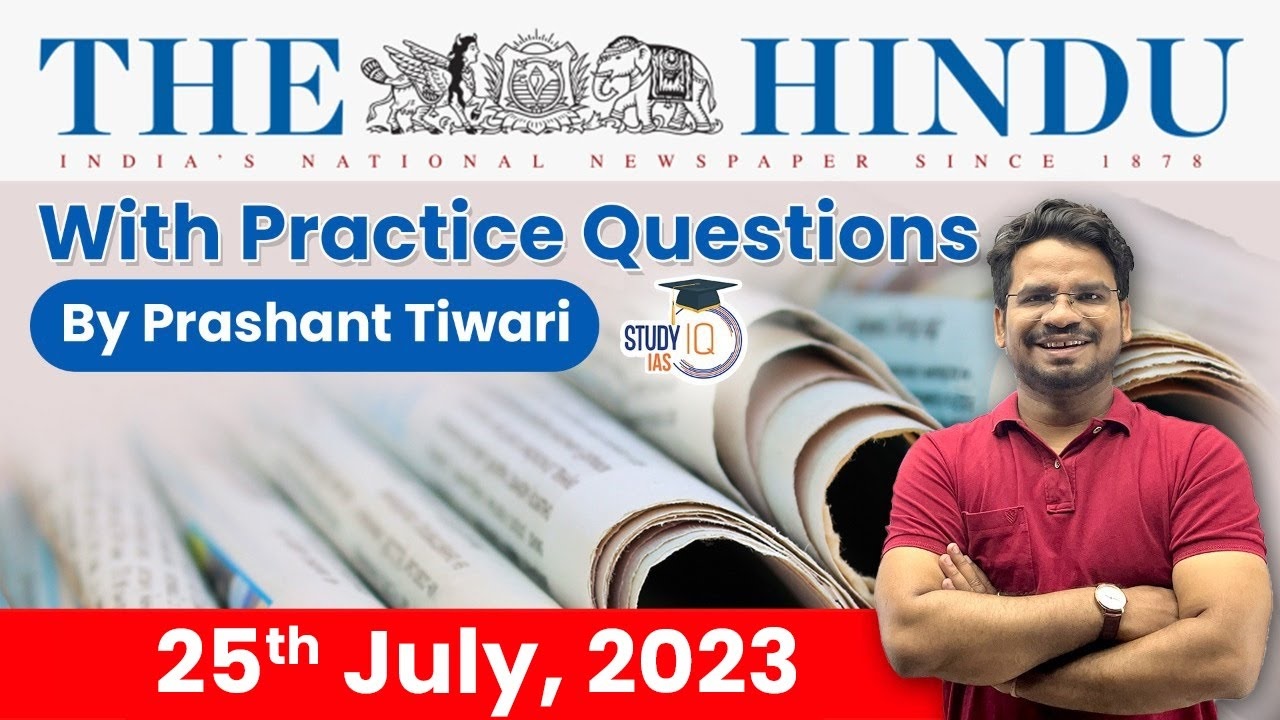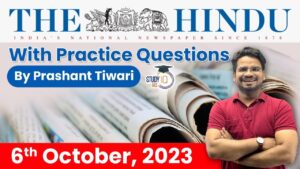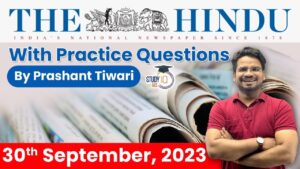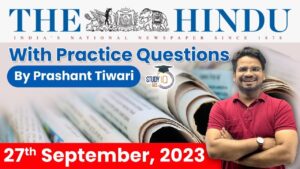The Hindu Newspaper Analysis for UPSC

The Hindu Newspaper Analysis 24 July 2023
- Manipur was boiling since February 2023
- Manipur has been restive since February when the state government launched an eviction drive seen as targeting a specific tribal group.
- The drive led to protests but not on the scale of the one seen recently.
- High Court’s order as a tigger point
- The recent protests were triggered by the Manipur High Court’s direction to the State to pursue a 10-year-old recommendation to grant Scheduled Tribe (ST) status to the non-tribal Meitei community.
- The Court’s order has brought the historical tensions between the valley-dwelling Meitei community and the state’s hill tribes to a boil.
The Hindu Editorial Today

- The Indian Space Research Organisation on Monday announced that the PSLV-C56 carrying Singapore’s DS-SAR satellite will be launched on July 30 from Sriharikota.
- The PSLV-C56 carrying DS-SAR satellite will be launched along with six other satellites. According to ISRO, the PSLV-C56 is configured in its core-alone mode, similar to that of C55. It would launch DS-SAR, a 360 kg satellite into a near-equatorial orbit at 5 degrees inclination and 535 km altitude. It added that the satellite is developed under a partnership between DSTA (representing the Government of Singapore) and ST Engineering. It will be used to support the satellite imagery requirements of various agencies within the Government of Singapore.
- DS-SAR carries a Synthetic Aperture Radar payload developed by Israel Aerospace Industries. This allows the DS-SAR to provide for all-weather day and night coverage and is capable of imaging at 1m resolution at full polarimetry.


- There was controversy recently over how sound data collection procedures in India are, especially when it comes to some of the important national level surveys.
- doubts on the soundness of data collection procedures of some of the surveys such as the National Sample Survey (NSS), National Family Health Survey (NFHS) and Periodic Labour Force Survey (PLFS).
- In support of her argument, the writer said that from 2011-12 till 2019-21, out of 11 surveys listed in her article, ‘every survey (except NFHS-4 of 2015-16) underestimates the proportion of the urban population or overestimates the rural population significantly’.
- The Government of India recently appointed a panel under the chairmanship of Dr. Pronab Sen to review the methodology of the National Statistical Organisation.
- National level data is a key resource for research, policymaking and development planning, so it is of utmost importance to understand and analyse both claims in the light of existing evidence.
- For this purpose, we will be taking a closer look at NFHS data, which is being conducted by the Ministry of Health and Family Welfare for the last 30 years with the International Institute of Population Sciences (IIPS) as the nodal agency.

- China enjoys close political and economic relations with the ASEAN states, and at least three of them, i.e., Laos, Cambodia and Myanmar, are its virtual dependencies. While the Philippines has become more assertive of late in its claims in the South China Sea, the central players, Indonesia, Malaysia, Singapore and Thailand, are all favourably disposed towards Beijing.
- The significance of the ASEAN meetings to India is apparent when viewed in the context of External Affairs Minister S. Jaishankar preferring to represent India at the post-ministerial conference and other regional dialogues, instead of accompanying the Prime Minister on his visits to France and the United Arab Emirates earlier in July.

- The Association of Southeast Asian Nations (ASEAN) is a regional grouping that aims to promote economic and security cooperation among its ten members: Brunei, Cambodia, Indonesia, Laos, Malaysia, Myanmar, the Philippines, Singapore, Thailand, and Vietnam.
- Establishment: It was established on 8 August 1967 in Bangkok, Thailand, with the signing of the ASEAN Declaration (Bangkok Declaration) by the founding fathers of ASEAN: Indonesia, Malaysia, Philippines, Singapore and Thailand.
- Aim: The motto of ASEAN is “One Vision, One Identity, One Community”.
- Secretariat: ASEAN Secretariat is located in Jakarta, Indonesia.
- ASEAN countries have a total population of 662 million people and a combined gross domestic product (GDP) of $3.2 trillion as of 2022.

- With a joint statement on economic cooperation, India and Sri Lanka outlined a forward-looking vision for their relations. The statement, entitled “Promoting Connectivity, Catalysing Prosperity: India-Sri Lanka Economic Partnership Vision”, released after talks between Prime Minister Narendra Modi and Sri Lankan President Ranil Wickremesinghe in Delhi last week, lays out the vision in five areas: maritime, air, energy, trade and people-to-people initiatives.
- A memorandum of understanding was signed to operationalise UPI digital payments in Sri Lanka and to designate the Indian Rupee as currency for trade.
- While the vision statement revealed a comprehensive plan for the future, what it lacked was conspicuous: none of the written documents released during Mr. Wickremesinghe’s visit acknowledged previous commitments by Sri Lanka on honouring the 13A constitutional amendment for devolution of powers to the North and Eastern provinces, and for resolving the long-pending issues over arrest of Indian fishers.

- The legal wrangling between the Centre and the Government of the National Capital Territory (NCT) of Delhi over the contours of their respective powers is a never-ending saga.
- The crux of the issue is that the ordinance has sought to nullify a recent Constitution Bench verdict that ruled that the subject of ‘Services’, covered under Entry 41 (State List), will fall under the executive and legislative domains of the Delhi government, and not that of the Centre.
- The Court’s earlier reasoning was simple: Article 239AA, which governs the affairs of the NCT of Delhi, excluded only three subjects from the Delhi government’s purview — police, public order and land — and that it could exercise control over the remaining subjects.
- The three-judge Bench that referred the ordinance matter to a Constitution Bench has noted that the creation of a new ‘Authority’ to regulate ‘services’ effectively amends Article 239AA of the Constitution because it becomes a fourth subject in the list of excluded ones.
- However, this may not necessarily invalidate it. Clause 7 of Article 239AA allows Parliament to enact laws “for giving effect to, or supplementing” the Article. Further, it stipulates that such a law would not be deemed an amendment to the Constitution, even if it has such an effect.

- Disasters around the world are claiming more and more lives. The consequences of climate change are already on our doorstep. Ten days ago, three continents were gripped by heat waves. Massive forest fires have ravaged parts of Greece and Canada. Two weeks ago, the river Yamuna breached the highest flood level, recorded 45 years ago, and inundated parts of Delhi.
- The cost of these disasters is yet to be determined.
- Sendai Framework for Disaster Risk Reduction 2015-2030, which is the global road map for reducing disaster risks and losses.
- One good news is that countries are finally coming around to the value of disaster risk reduction, which India has elevated as a priority for G20 through its presidency of the group. Specifically, India has established the first G20 Disaster Risk Reduction Working Group.
Sendai Framework for Disaster Reduction 2015-30
- It was adopted at the Third United Nations World Conference on Disaster Risk Reduction, held from March 14 to 18, 2015 in Sendai, Miyagi, Japan.
- The present Framework applies to the risk of small-scale and large-scale, frequent and infrequent, sudden and slow-onset disasters caused by natural or man-made hazards, as well as related environmental, technological and biological hazards and risks.
- It aims to guide the multi hazard management of disaster risk in development at all levels as well as within and across all sectors.
- It is the successor instrument to the Hyogo Framework for Action (HFA) 2005-2015: Building the Resilience of Nations and Communities to Disasters
Coalition for Disaster Resilient Infrastructure (CDRI)
About:
- The CDRI was launched by the Prime Minister of India during the United Nations Climate Action Summit on the 23rd September, 2019, at New York.
- It is a global partnership of National Governments, UN agencies and programmes, multilateral development banks and financing mechanisms, the private sector, academic and knowledge institutions .
- It aims to promote the resilience of infrastructure systems to climate and disaster risks, thereby ensuring sustainable development.
Members:
- Since its launch, thirty-one (31) Countries, six (06) International Organisations and two (02) private sector organisations have joined as members of CDRI.
- CDRI has been expanding its membership consistently by attracting a wide variety of economically advanced countries, developing countries, and countries that are most vulnerable to climate change and disasters.

- With aggregate rainfall in the country rising above the long-term average, Kharif crop sowing has picked up pace to lift overall levels 1.2% over last year by July 21, from a 2% deficit recorded a week earlier, spurring hopes of a relief in the pace of price rise of some food items.
- Most significantly, the overall sown area for rice, which was lagging over 6% from last year’s level as of July 14, touched 180.2 lakh hectares by July 21, 2.7% higher than a year ago. The sown area for pulses increased over the same period, but remained nearly 10% below last year.
- What are Rabi Crops?
- These crops are sown around the Retreating Monsoon and Northeast monsoon season, which begins in October and are called rabi or winter crops.
- The harvest for these crops happens typically during April and May, during the summer season.
- These crops are not much affected by the rainfall.
- Major Rabi crops are wheat, gram, peas, barley etc.
- A warm climate is required for seed germination and cold climate for the growth of crops.
- Kharif Crops:
- Crops that are sown during the southwest monsoon season are called kharif or monsoon crops.
- These crops are sown at the beginning of the season around end May to early June and are harvested post the monsoon rains beginning October.
- These crops depend on the rainfall patterns.
- Rice, maize, pulses such as urad, moong dal and millets are among the key kharif crops.
- It requires a lot of water and hot weather to grow.

- The Bill applies to “aggregators” (digital intermediaries connecting buyers and sellers) and “primary employers” (individual or organisations engaging platform-based workers). The Bill proposes a Welfare Board comprising State officials, five representatives each from gig workers and aggregators, and two others from civil society.
- The Board will “set up a welfare fund, register platform-based gig workers, aggregators and primary employers… facilitate guarantee of social security to platform-based gig workers and to provide for matters connected therewith or incidental thereto.” The Board will maintain a database of companies and workers and each worker will receive a unique ID which “shall be valid in perpetuity.”
- According to the Bill, the Board will create a “Social Security and Welfare Fund” comprising contributions made by individual workers, State government aids, other sources and a ‘welfare cess’ — a cut from each transaction — which the aggregator is required to pay.
- Gig workers “have an opportunity to be heard for any grievances” with “entitlements, payments and benefits provided under the Act.”
- An aggregator’s duties under the Bill include: depositing welfare cess on time, updating the database of gig workers, and documenting any variations in numbers within one month of such changes.
- If they fail to comply, they will be fined up to ₹5 lakh for the first offence and ₹50 lakh for further violations; primary employers will pay up to ₹10,000 for the first offence and ₹2 lakh for subsequent violations.

- Slaked lime (chuna) is an alkali compound widely used as a binding agent, along with betel nut and other ingredients, to make paan in the Indian subcontinent. A new study has found that chuna is a major cause for ocular burns among children, along with household chemicals and fireworks. The study was published in the July 2023 edition of the Indian Journal of Ophthalmology.
- Loosely sold in plastic packets, the quicklime can puff out of the packet on to a child’s eyes. The alkali then burns the ocular surface and can result in eye injury. They are a tragic cause of ocular morbidity, even vision loss, especially among children.
- Indian paan contains slaked lime, or chuna (sunnam in Telugu; sunna in Kannada; sunnaampu in Tamil), which is smeared onto a betel leaf and chewed along with the areca nut.
- Such injuries can be avoided if the substance causing them is stored safely, away from the reach of children. Adults who are at risk of workplace injuries — since lime is also present in whitewash, for example — will benefit from protective eye glasses.
- Firecrackers are a known risk for burns, and people should be made aware of the risk of ocular injury as well. All the usual safety measures — sourcing good-quality firecrackers, using them in open areas where bystanders, especially children, are at a safe distance — apply.


 The Hindu Newspaper Analysis 6 October 2...
The Hindu Newspaper Analysis 6 October 2...
 The Hindu Newspaper Analysis 30 Septembe...
The Hindu Newspaper Analysis 30 Septembe...
 The Hindu Newspaper Analysis 27 Septembe...
The Hindu Newspaper Analysis 27 Septembe...

























